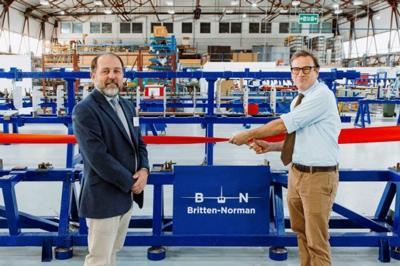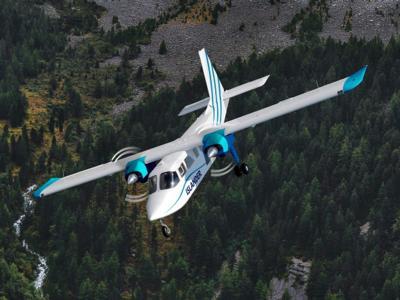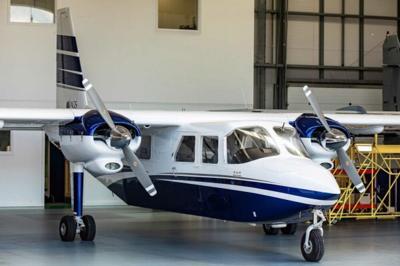Coming Home to Roost
In the late 1960s, for purpose of contemporaneously meeting demand and controlling production costs, Britten-Norman moved its manufacturing operations from the U.K. to Romania.

In an ironic reversal of fortune, the company, in June 2023, announced aircraft production would return to Britten-Norman’s historic digs in the village of Bembridge on the U.K.’s Isle of Wight.
Britten-Norman CEO William Hynett stated at the time: “We are immensely proud to bring production back to the U.K., where our manufacturing story began nearly seven-decades ago. This move underlines our dedication to the highest standards of quality, innovation, and the resurgence of British aerospace manufacturing.”
In keeping with the once-and-future British plane-maker’s aspirations to modernize its popular BN-2 Islander model and boost production thereof, Britten-Norman has invested in new tooling and jigs by dint of which it will open two additional Bembridge production lines.
A ribbon-cutting ceremony marking the openings of the new plant and production line was held on 21 September and presided over by Isle of Wight MP (Member of Parliament) Bob Seely.
Comes now October 2023 and, for the first time in 55-years, production of Britten-Norman Islander aircraft is underway in the U.K. The planes currently under construction are slated to be completed in May 2024. Citing improved supply-chain efficiency and the Bembridge facility’s enhanced production capabilities, Britten-Norman, in a paroxysm of optimistic vigor, set forth it expects new aircraft output to increase four-fold by 2027.

First flown in June 1965 and continuously upgraded since, Britten-Norman’s BN-2 Islander is a light-utility aircraft and regional airliner. Over its protracted production run, the Islander has consistently remained among Europe’s best-selling commercial aircraft types. Currently, some 750 specimens of the machine are in service with upwards of thirty commercial operators worldwide.
Britten-Norman’s current production Islander model features IFR-certified G600 and GTN series EFIS suites comprising G600 TXi Primary Flight Display (PFD) and Multiple Flight Display (MFD) with integrated DME, GTN 750/650 dual nav/comm and GPS, Electronic Engine Display, a remote digital audio system, ADS-B Out transponder, and Bluetooth connectivity. Aft of the cockpit bulkhead, the Islander’s cabin features all-window seating and plentiful baggage storage.
Current production Britten-Norman Islanders can be equipped with a variety of engines, to include Lycoming’s 260-horsepower, normally-aspirated and three-hundred-horsepower fuel-injected piston powerplants; and 320 and four-hundred-horsepower Rolls-Royce turboprop mills. So motivated, the 4,114-pound (empty-weight) aircraft can move a 3,517-pound useful-load over a (maximum) 755-nautical-mile range at a top-speed of 148-knots.

Britten-Norman intends to offer customers the option to upgrade to the company’s zero-emission Islander—an as-of-yet nonexistent contraption being developed in collaboration with the U.K.’s Cranfield Aerospace Solutions (CAeS).
Currently, the Britten-Norman-Cranfield Aerospace Solutions partnership is working to develop and deliver a flying demonstrator showcasing hydrogen propulsion technology and a clear route to market. The project is being funded by the Aerospace Technology Institute, a U.K. organization promoting transformative technology in air-transport and funding research germane to such via a £3.9-billion joint government-industry program.
Britten-Norman hopes to see the zero-emission Islander enter service in 2026.
 Aero-FAQ: Dave Juwel's Aviation Marketing Stories -- ITBOA BNITBOB
Aero-FAQ: Dave Juwel's Aviation Marketing Stories -- ITBOA BNITBOB NTSB Prelim: Rutan Long-EZ
NTSB Prelim: Rutan Long-EZ ANN's Daily Aero-Term (12.05.25): Hazardous Weather Information
ANN's Daily Aero-Term (12.05.25): Hazardous Weather Information Aero-News: Quote of the Day (12.05.25)
Aero-News: Quote of the Day (12.05.25) Airborne-Flight Training 12.04.25: Ldg Fee Danger, Av Mental Health, PC-7 MKX
Airborne-Flight Training 12.04.25: Ldg Fee Danger, Av Mental Health, PC-7 MKX





